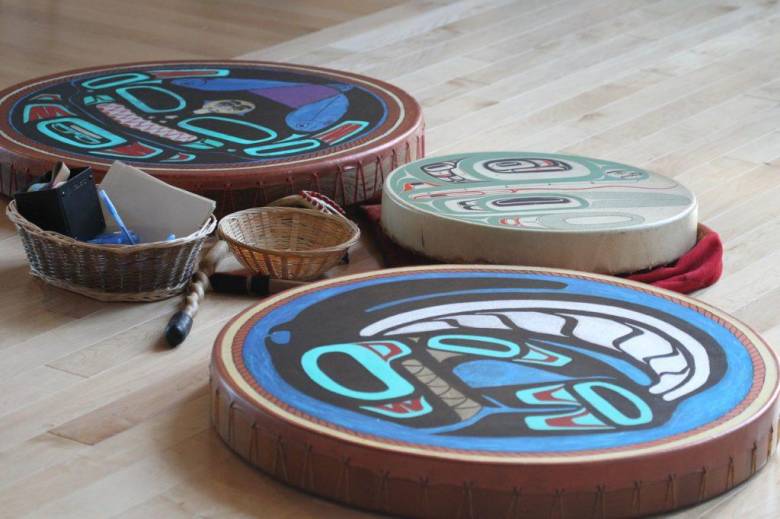
Image: Captain Gold, Haida Gwaii Knowledge Exchange Workshop. February 8-9, 2019. Haida Gwaii Museum.
Beauty and Resilience: Indigenous Art in Canada is a six-part lecture series developed by Dr. Gerald McMaster and the Wapatah: Centre for Indigeous Visual Knowledge for the Curious Minds Speaker Series at HotDocs.
Available to stream, as part of the Curious Minds Speakers series on Hot Docs | WATCH HERE
Series at a Glance:
The art and culture of Turtle Island is immense and rich in its diversity. Focusing on First Nations, Inuit, and Métis artists, this thought-provoking series explores the many ways that Indigenous artists have contributed to the vibrancy of Canada’s visual art tradition. Examining the thriving community of contemporary creators, such as Kent Monkman and Christi Belcourt, and the rich historical legacy of artists like Norval Morrisseau and Bill Reid—and the regional cultures and landscapes that have inspired their work—the series offers a unique and visually stunning perspective on the complexity and ingenuity of the great artistic traditions that form our cultural bedrock.
Curious Minds Speaker Series has been developed as an opportunity for a deeper viewer engagement with an array of fascinating subjects as they are explored by acclaimed lecturers and cultural leaders, their themes ranging from the enlightenment, to city design, to the effects of climate change on global geographies.
Lecture 1: Traditional Knowledge: Art is Spirit, Spirit is Art
The passing down and embodiment of traditional knowledge and Indigenous visual knowledge forms the basis of life among Indigenous communities. In this lecture, we bring to the forefront how contemporary Indigenous artists are flipping the script by embracing and drawing upon traditional knowledge as a way of seeing, living, and creating outside the Western perspective.
Lecture 2: Inuit Art: Resourcefulness and Innovation
For thousands of years Inuit and their ancestors have made their own clothes, built their homes, hunted, and raised families. In this lecture, we examine Inuit art through the lens of societal values and language, exploring how Inuit resourcefulness has influenced the modern world in architecture, fashion and technology, as well as the way we view the land in a rapidly changing climate.
Lecture 3: The Entangled Gaze: How Indigenous Artists Viewed Colonial Settlers
In this lecture we explore the complex history of contact in different regions of Canada and the contiguous United States through the lens of Indigenous artists who were creating at this time. By reversing the gaze of the European and Euro/American/Canadian artists, this lecture answers the question of how Indigenous artists viewed, and were able to capture, the European other.
Lecture 4: Struggle, Resilience, Beauty: The Art of Iljuwas Bill Reid (1920-1998)
Iljuwas Bill Reid (1920–1998) was a gifted artist who catalyzed the reclamation of Haida culture and went on to become one of the most significant Northwest Coast artists of the 20th Century. During his fifty-year career, he prolifically created art while also advocating for the inherent rights of the Haida people in defending their land and way of life—leaving behind a legacy of struggle, collective resilience and powerful beauty making.
Lecture 5: Reversing the Gaze: Re-enactment in Indigenous Art
In this lecture we explore the tradition of re-enactment—the interpretation, commemoration and renegotiation of moments of the past—and how Indigenous artists use it to take control of narratives and dismantle stereotypes, creating deeply empowering works of imagination.
Lecture 6: From the Arctic to the Amazon: Indigenous Art in a Global Perspective
At opposite ends of the earth, the Arctic and Amazon regions are inhabited by Indigenous peoples who have thrived in intense climates. This lecture draws a sharper focus on how much Indigenous communities from diverse geographic locations have in common when they come into contact with each other, and how through art they have created a common space of contemplation and knowledge.
Spotlighting Wapatah Team Contributors: Natalja Chestopalova, Brittany Pitseolak Bergin, Mariah Meawasige, Panya Clark Espinal, Na’ama Freeman, Alessia Rose Pignotti, and Jananda Lima.